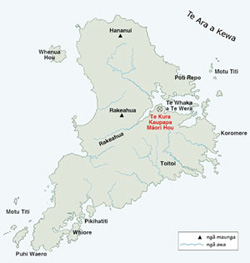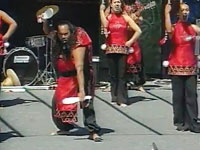| PREFACE |
HE
KUPU WHAKATAKI |
In
2005, there were significant changes in the approach to
the assessment of students in Mäori medium settings,
so this report is substantially different to earlier NEMP
reports on Mäori student achievement. The changes
to note are:
• the 2005 assessments were carried out in Mäori
medium schools only, whereas the earlier assessments included
both Mäori medium schools and Mäori medium classes
in mainstream schools.
• the 2005 assessment was carried out entirely in
te reo Mäori, whereas some of the students were assessed
partially in English in the earlier assessments.
• unlike its predecessors, this report focuses solely
on the Mäori medium assessment results, without comparative
data on the achievements of Mäori students learning
in English medium schools.
• for the first time, the majority of the work required
for national monitoring in Mäori medium schools was
undertaken by He Kupenga Hao i te Reo, a group based in
Palmerston North whose sole focus is on Mäori medium
education, rather than by the NEMP team based at the University
of Otago.
New Zealand’s
National Education Monitoring Project commenced in 1995, with
the task of assessing and reporting on the achievement of New
Zealand primary school children in all areas of the school curriculum.
In English medium, children are assessed at two class levels:
year 4 (halfway through primary education) and year 8 (at the
end of primary education). Only year 8 students are assessed in
Mäori medium. Different curriculum areas and skills are
assessed each year, over a four-year cycle. In 2005, the areas
covered were Social Studies, Information Skills, and Mathematics.
The main goal of national monitoring is to provide detailed information
about what children can do so that patterns of performance can
be recognised, successes celebrated, and desirable changes to
educational practices and resources identified and implemented.
Each year, small random samples of children are selected nationally,
then assessed in their own schools by teachers specially seconded
and trained for this work. Task instructions are given orally
by teachers, through video presentations, on laptop computers,
or in writing. Many of the assessment tasks involve the children
in the use of equipment and supplies. Their responses are presented
orally, by demonstration, in writing, in computer files, or through
submission of other physical products. Many of the responses are
recorded on videotape for subsequent analysis.
| THIS
REPORT |
TËNEI
PÜRONGO |
This
report focuses solely on year 8 Mäori medium students.
Starting in 1999, assessments of students learning in Mäori
immersion education programmes were added to the national
monitoring programme, at the year 8 level only. In 2005,
all schools were either Kura Kaupapa Mäori, Kura Mana
Mäori, or full Mäori immersion schools. A small
number of assessment tasks were developed from ideas put
forward at a meeting of year 8 Mäori medium teachers,
the balance of tasks were translated and adapted from English
medium tasks. They were administered by teachers experienced
in Mäori immersion settings. The results these students
achieved are reported task by task.
|
1 : KEY FEATURES |
NGÄ
ÄHUATANGA MATUA |
Chapter
1 explains key features of the National Education Monitoring
Project that are relevant to this report.
|
|
Chapter
2 explains some of the issues surrounding the 2005 assessments
in Mäori immersion education settings:
• the responses and attitudes of Mäori medium schools
to national monitoring
• the suitability of tasks for Mäori medium monitoring
• the linguistic complexity of some tasks
• the academic language proficiency of some students
• the representivity of the 2005 student sample
• the central role played by the teacher administrators in
ensuring the students are motivated and show the depth and breadth
of their knowledge, understandings and skills
|
3 : INFORMATION SKILLS |
NGÄ
PÜKENGA PÄRONGO |
|
|
Chapter
3 presents the results of the assessments of students’
information skills. Students possessing well developed information
skills can perform three main tasks effectively: clarifying information
needs, finding and gathering relevant information, and then analysing
and using that information to meet the required purposes. A substantial
proportion of the intellectual demands occur during the first
and third of these tasks: finding and gathering information is
clearly important, but its value is greatly dependent on the extent
to which it can be validly interpreted and used to meet information
needs.
This chapter reports on student achievement in 14 of the information
skills tasks. Generally students performed well on tasks requiring
them to extract information from a text, however were less successful
in more cognitively demanding tasks requiring them to evaluate
and synthesise information, connect information to wider issues
and ideas, and express and justify opinions. |
|
4: SOCIAL STUDIES |
NGÄ
TIKANGA Ä-IWI |
|
|
Chapter
4 presents results of the assessments of students’
knowledge, understanding and skills in social studies. The stated
aim of social studies education is to enable students to participate
in a changing society as informed, confident and responsible
citizens. To help achieve this outcome, students are expected
to acquire knowledge that will inform and contribute towards
their understandings about resposibilities, relationships, culture,
heritage and management of the environment and resources. They
are also expected to develop the skills needed to live and contribute
as effective and worthy members of society.
|
| Results
from 13 of the tikanga ä-iwi tasks are presented in this
report and again, students generally perfomed well in tasks
requiring comprehension of a text, but less well in connecting
ideas to wider issues, and in identifying and discussing a range
of possible opinions or behaviours. Overall performance in tasks
involving economics requires concentrated attention. |
|
5: MATHMATICS |
TE
PÄNGARAU |
|
Chapter
5 presents the results of the assessments of students’
knowledge, understanding and skills in mathematics. Conceptual
understanding is a central goal of mathematics education.
Mathematics education is very much concerned with such matters
as students’ confidence, interest and inventiveness
in working with a range of mathematical ideas. It aims to
help students develop their capacity for exploring, applying
and communicating their mathematical understandings with real-world
contexts. While confidence and efficiency in basic knowledge
of facts is important, a substantial focus is also placed
on thinking, reasoning and problem-solving skills, requiring
more open tasks that allow students to demonstrate their number
sense, reason, make decisions and explain.
|
|
| This
chapter reports on the results of 35 of the pängarau tasks.
Overall performance in tasks requiring the recall of basic number
facts was good. However, students’ understanding of fractions
and their ability to perform operations involving fractions
was poor, as was an understanding of the effect of variability
in problems involving chance, and the ability to recognise and
use algebraic relationships between variables. |
Chapter
6 reports the results of surveys of students about their curriculum
preferences and perceptions of their achievement and potential in
pükenga pärongo, tikanga ä-iwi and pängarau.
Overall, students were positive about these aspects of the school
curriculum as well as their ability and future learning in these areas.
|



